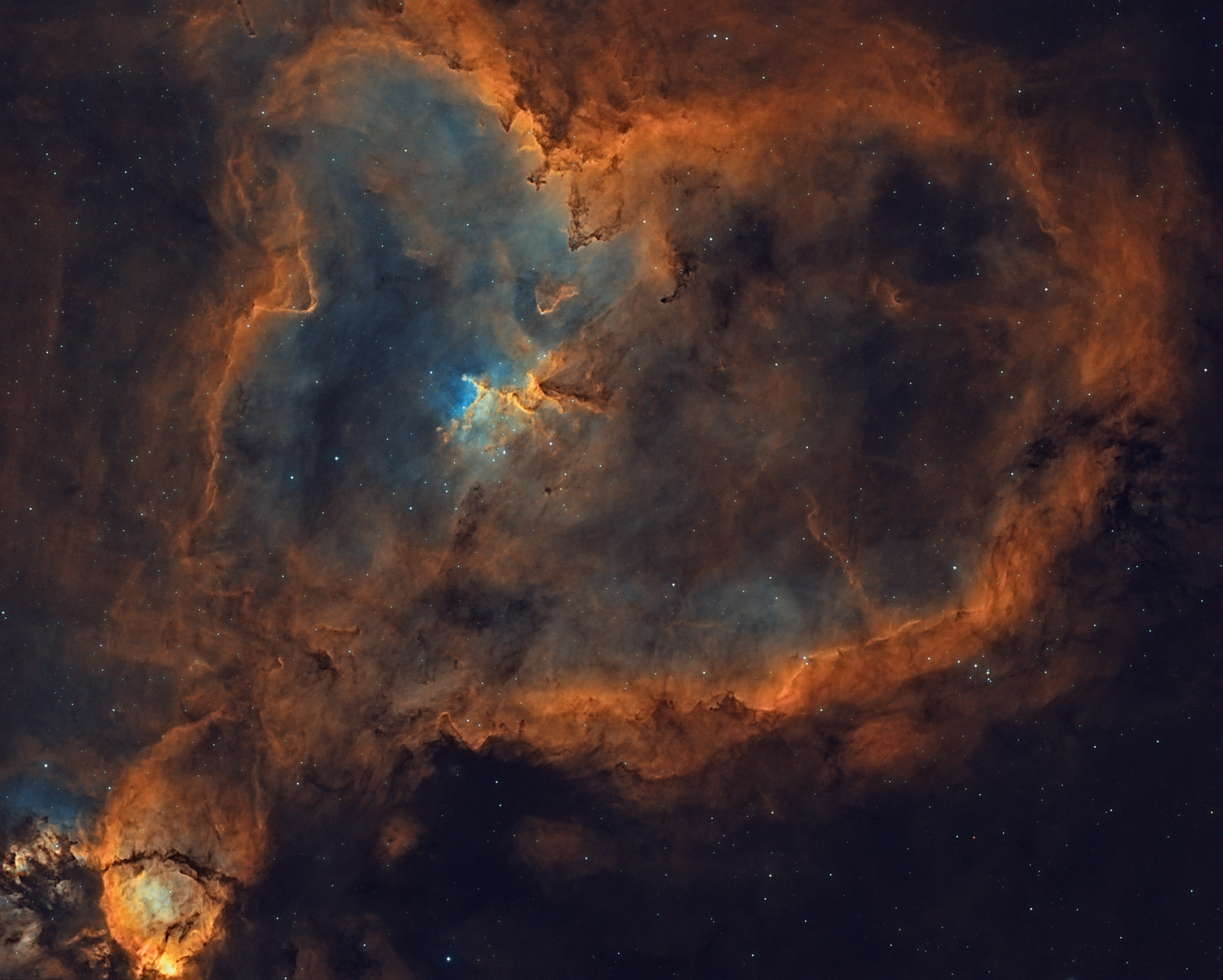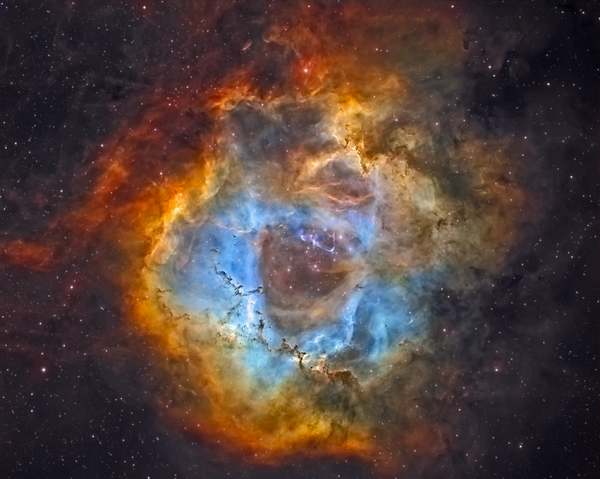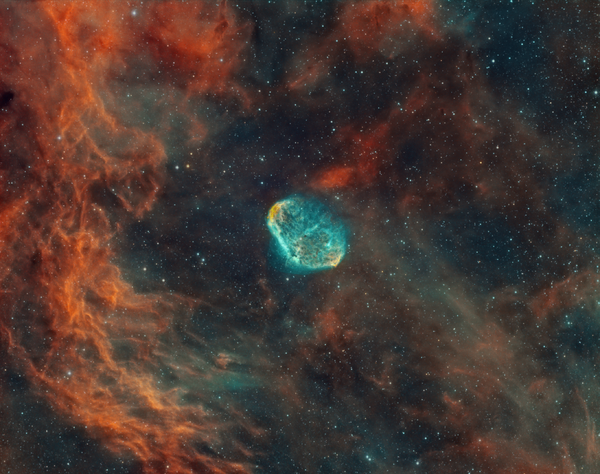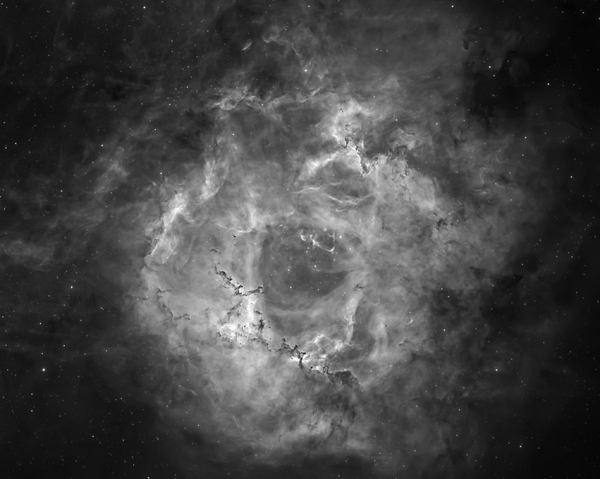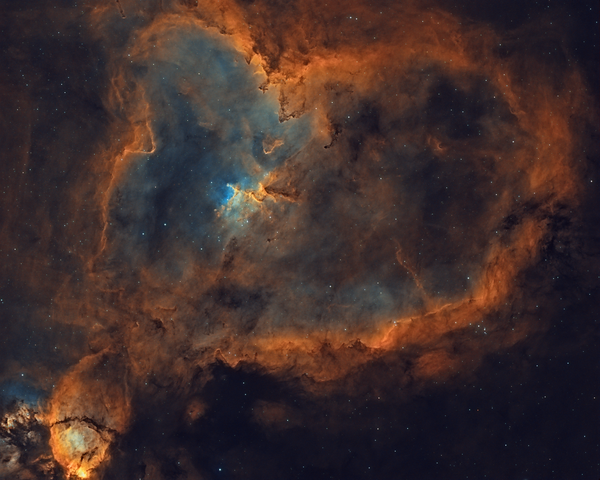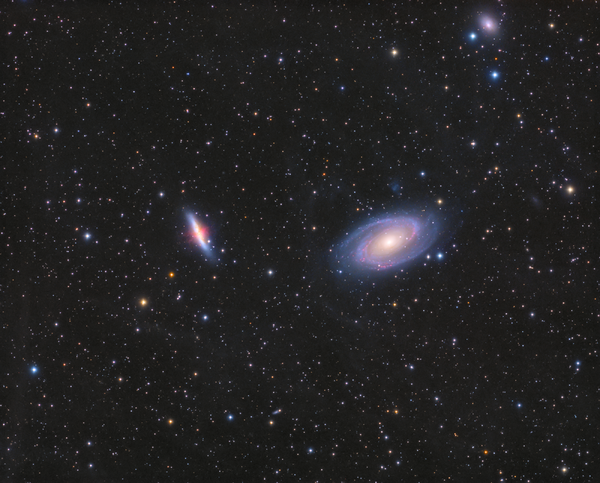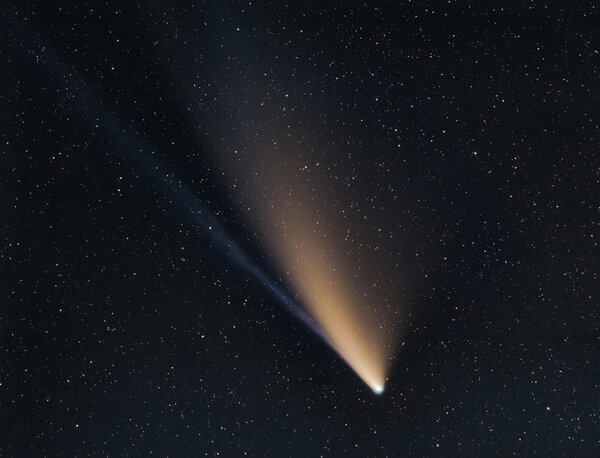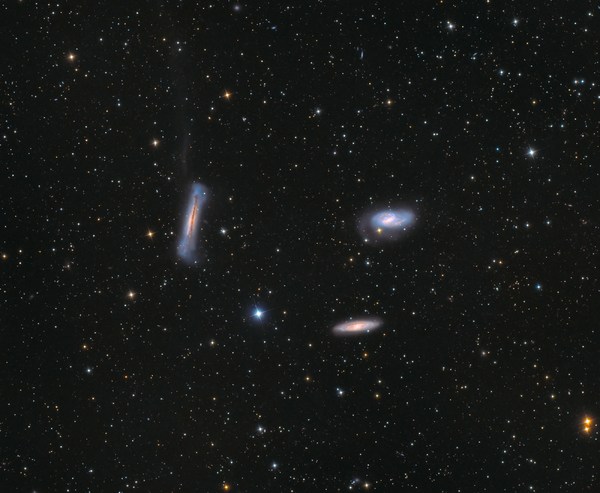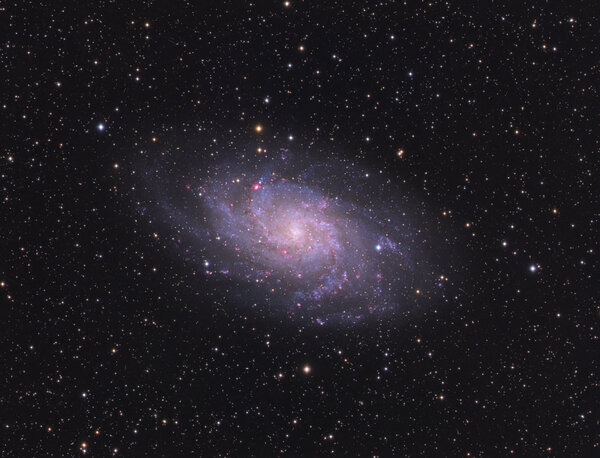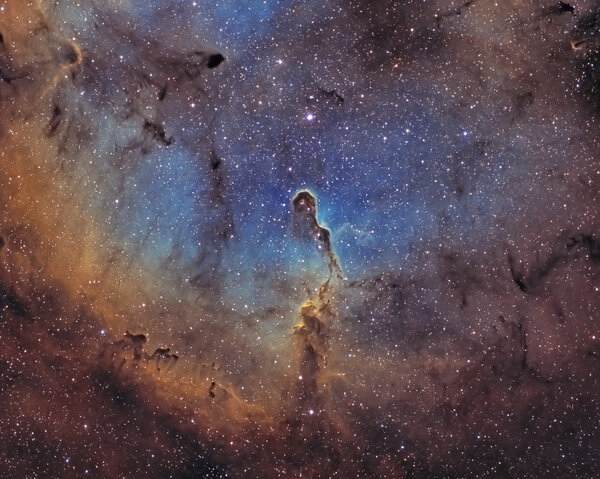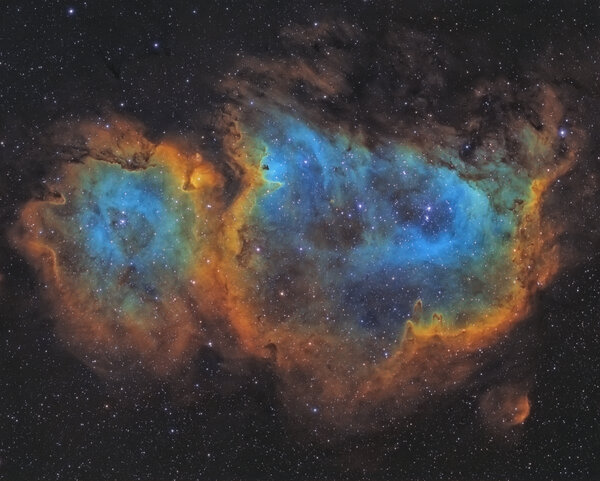-
Αναρτήσεις
48 -
Εντάχθηκε
-
Τελευταία επίσκεψη
-
Ημέρες που κέρδισε
8
Τύπος περιεχομένου
Forum
Λήψεις
Ιστολόγια
Αστροημερολόγιο
Άρθρα
Αστροφωτογραφίες
Store
Αγγελίες
Όλα αναρτήθηκαν από Konstantinos Tsekas
-
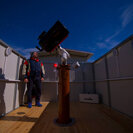
*** Rosette Nebula *** (Νεφέλωμα της Ροζέτας)
Ο Konstantinos Tsekas σχολίασε σε Konstantinos Tsekas για αστροφωτογραφία Υπόλοιπα Deep Sky
-
The Crescent Nebula (also known as NGC 6888, Caldwell 27, Sharpless 105) is an emission nebula in the constellation Cygnus, about 5000 light-years away from Earth. It was discovered by William Herschel in 1792.It is formed by the fast stellar wind from the Wolf-Rayet star WR 136 (HD 192163) colliding with and energizing the slower moving wind ejected by the star when it became a red giant around 250,000 to 400,000[citation needed] years ago. The result of the collision is a shell and two shock waves, one moving outward and one moving inward. The inward moving shock wave heats the stellar wind to X-ray-emitting temperatures. Location: Stinger of Scorpius Observatory, Filiates, Thesprotia - Greece. Work is ready..... Bortle Scale: Class 4 Constellation: Cygnus Imaging Telescope: William optics star 71 f/4.9 Equatorial Mount: Avalon linear fast reverse (Avalon Instruments) Guide Scope : Skywatcher ed80 Black Diamond Guide Camera:ZWO ASI290MM Mini (mono) Main Camera: CCD Atik One 6.0 Monochrome Filters: Astrodon Hydrogen Alpha 5nm Exposures: 45X600sec for Hydrogen Alpha : (7.5 hours total) : 42X600sec Oxygen iii : ( 7.0 hours total) Binning: 1x1 Image Calibration: 60 dark frames, 230 bias frames, 35 flat frames Sensor temperature: -10°C Image acquisition software: Artemis Capture Telescope guiding software: PHD2 Processing software: Pixinsight - CCD stack - Photoshop CS6 Acquisition dates: 05/06/2021 - 29/06/2021 (H-Alpha Filter) 12/07/2021 - 14/07/2021 (Oiii filter) Total exposure : 14.5 hours
- 2 σχόλια
-
- 1
-

-

*** Rosette Nebula *** (Νεφέλωμα της Ροζέτας)
Konstantinos Tsekas δημοσίευσε μία αστροφωτογραφία σε Υπόλοιπα Deep Sky
The Rosette Nebula (also known as Caldwell 49) is an H II region located near one end of a giant molecular cloud in the Monoceros region of the Milky Way Galaxy. The open cluster NGC 2244 (Caldwell 50) is closely associated with the nebulosity, the stars of the cluster having been formed from the nebula''s matter. ----------------------------------------------- Το νεφέλωμα της Ροζέτας ή του Ρόδακα (γνωστό και ως Caldwell 49) είναι μεγάλη περιοχή ΗΙΙ (μορφή νεφελώματος) στον αστερισμό Μονόκερως. Απέχει από τη Γη περίπου 5.000 - 5.200 έτη φωτός και έχει διάμετρο περίπου 130 έτη φωτός. Η μάζα του υπολογίζεται σε περίπου 10.000 ηλιακές μάζες. Location: Stinger of Scorpius Observatory, Filiates, Thesprotia - Greece. Work is ready..... Bortle Scale: Class 4 Constellation: Monoceros Imaging Telescope: William optics star 71 f/4.9 Equatorial Mount: Avalon linear fast reverse (Avalon Instruments) Guide Scope : Skywatcher ed80 Black Diamond Guide Camera:ZWO ASI290MM Mini (mono) Main Camera: CCD Atik One 6.0 Monochrome Filters: Astrodon Hydrogen Alpha 5nm Astrodon Oxygen iii 3nm Baader Sulfor ii 8nm Exposures: 33X600sec for Hydrogen Alpha : (5.5 hours total) 24X600sec for Oxygen iii : (4 hours total) 24X600sec for Sulfor ii : (4 hours total) Binning: 1x1 for each filter Image Calibration: 60 dark frames, 230 bias frames, 35 flat frames Sensor temperature: -10°C Image acquisition software: Artemis Capture Telescope guiding software: PHD2 Processing software: Pixinsight - CCD stack - Photoshop CS6 Acquisition dates: 05/02/2021 (H-Alpha Filter) 03/03/2021 (O iii Filter) 01/04/2021 - 08/04/2021 (S ii Filter) Total exposure : 13.5 hours -

*** Monoceros Constellation *** *** Νεφέλωμα της Ροζέτας ***
Konstantinos Tsekas δημοσίευσε μία αστροφωτογραφία σε Υπόλοιπα Deep Sky
Το νεφέλωμα της Ροζέτας ή του Ρόδακα είναι μεγάλη περιοχή ΗΙΙ (μορφή νεφελώματος) στον αστερισμό Μονόκερως. Απέχει από τη Γη περίπου 5.000 - 5.200 έτη φωτός και έχει διάμετρο περίπου 130 έτη φωτός. Η μάζα του υπολογίζεται σε περίπου 10.000 ηλιακές μάζες. Το ανοικτό σμήνος NGC 2244 σχετίζεται με το νεφέλωμα. Η ακτινοβολία από τα μέλη του σμήνους απορροφάται από τα αέρια του, τα οποία στη συνέχεια ιονίζονται και εκπέμπουν την επιπλέον ενέργεια με τη μορφή ακτινοβολίας. Οι ισχυροί αστρικοί άνεμοι του μελών του σμήνους έχουν σχηματίσει μια κοιλότητα στο κέντρο του νεφελώματος. Location: Stinger of Scorpius Observatory, Filiates, Thesprotia - Greece. Work in progress..... Bortle Scale: Class 4 Constellation: Monoceros Imaging Telescope: William optics star 71 f/4.9 Equatorial Mount: Avalon linear fast reverse (Avalon Instruments) Guide Scope : Skywatcher ed80 Black Diamond Guide Camera:ZWO ASI290MM Mini (mono) Main Camera: CCD Atik One 6.0 Monochrome Filters: Astrodon Hydrogen Alpha 5nm Exposures: 33X600sec for Hydrogen Alpha : (5.5 hours total) Binning: 1x1 for Ha filter Image Calibration: 60 dark frames, 230 bias frames, 35 flat frames Sensor temperature: -10°C Image acquisition software: Artemis Capture Telescope guiding software: PHD2 Processing software: Pixinsight - CCD stack - Photoshop CS6 Acquisition dates: 03/02/2021 - 06/02/2021 (H-Alpha Filter) Total exposure : 5.5 hours -

**** Cassiopeia Constellation ****
Ο Konstantinos Tsekas σχολίασε σε Konstantinos Tsekas για αστροφωτογραφία Νεφελώματα
-

**** Cassiopeia Constellation ****
Ο Konstantinos Tsekas σχολίασε σε Konstantinos Tsekas για αστροφωτογραφία Νεφελώματα
-
*** The Heart Nebula, IC 1805 (Το νεφέλωμα της Καρδιάς) *** Το νεφέλωμα εκπομπής IC 1805, γνωστό και ως νεφέλωμα της Καρδιάς εξαιτίας του χαρακτηριστικού του σχήματος, βρίσκεται περίπου 7.500 έτη φωτός μακριά μας, στον αστερισμό της Κασσιόπης. Το νεφέλωμα αυτό σμιλεύθηκε από τους αστρικούς ανέμους και την υπεριώδη ακτινοβολία των νεαρών, γιγάντιων και υπέρθερμων άστρων, τα οποία εμπεριέχονται στο αστρικό σμήνος Melotte 15 που βρίσκεται στο κέντρο του. The Heart Nebula, IC 1805, Sharpless 2-190, lies some 7500 light years away from Earth and is located in the Perseus Arm of the Galaxy in the constellation Cassiopeia. It was discovered by William Herschel on 3 November 1787. It is an emission nebula showing glowing ionized hydrogen gas and darker dust lanes. Location: Stinger of Scorpius Observatory, Filiates, Thesprotia - Greece. Work is ready..... Processing: Kostas Tsekas - Aras Teo Bortle Scale: Class 4 Constellation: Cassiopeia Imaging Telescope: William optics star 71 f/4.9 Equatorial Mount: Avalon linear fast reverse (Avalon Instruments) Guide Scope : Skywatcher ed80 Black Diamond Guide Camera:ZWO ASI290MM Mini (mono) Main Camera: CCD Atik One 6.0 Monochrome Filters: Astrodon Hydrogen Alpha 5nm Astrodon Oxygen iii 3nm Baader Sulfor ii 8nm Exposures: 60X600sec for Hydrogen Alpha : (10 hours total) 45X600sec for Oxygen iii : (7.5 hours total) Binning: 1x1 for each filter Image Calibration: 60 dark frames, 230 bias frames, 35 flat frames Sensor temperature: -10°C Image acquisition software: Artemis Capture Telescope guiding software: PHD2 Processing software: Pixinsight - CCD stack - Photoshop CS6 Acquisition dates: 12/09/2020 - 13/09/2020 (H-Alpha Filter) 05/12/2020 - 15/12/2020 (O iii Filter) Total exposure : 17.5 hours
-

*** Messier 81 και Messier 82 ***
Ο Konstantinos Tsekas σχολίασε σε Konstantinos Tsekas για αστροφωτογραφία Γαλαξίες
-

*** Comet Neowise ***
Konstantinos Tsekas δημοσίευσε μία αστροφωτογραφία σε Κομήτες, Διάττοντες και Αστεροειδείς
*** Comet Neowise *** C/2020 F3 (NEOWISE) or Comet NEOWISE is a long period comet with a near-parabolic orbit discovered on March 27, 2020, by astronomers during the NEOWISE mission of the Wide-field Infrared Survey Explorer (WISE) space telescope. At that time, it was an 18th-magnitude object, located 2 AU (300 million km; 190 million mi) away from the Sun and 1.7 AU (250 million km; 160 million mi) away from Earth. By July 2020, it was bright enough to be visible to the naked eye. It is one of the brightest comets in the northern hemisphere since Comet Hale–Bopp in 1997. Under dark skies, it can be seen with the naked eye and might remain visible to the naked eye throughout most of July 2020. As of July 24, the comet was about magnitude 4, but binoculars are required near urban areas to locate the comet. The comet is getting further from the Sun and Earth, and a brightening waxing crescent moon is beginning to interfere with dark skies. -
*** Messier 81 και Messier 82 *** Location: Stinger of Scorpius Observatory, Filiates, Thesprotia - Greece. Processing: Kostas Tsekas - Aras Teo Telescope: William optics star 71 f/4.9 Mount: Avalon linear fast reverse Camera: CCD Atik One 6.0 Filter:Baader LRGB - Astrodon Ha 5 nm Guide:ZWO ASI290MM Mini (mono) + Skywatcher ed80 Process:CCD stack - Pixinsight - Photoshop CS6 Exposure: Luminance(Super Luminance), RED(Red+Ha), Green, Blue Luminance 48 exposures x 300sec Ha 18 x 600sec Red 24 x 300sec Green 24 x 300sec Blue 24 x 300sec Total: 13 hours total
-

*** Leo Triplet *** (Τριάδα του Λέοντα)
Ο Konstantinos Tsekas σχολίασε σε Konstantinos Tsekas για αστροφωτογραφία Νεφελώματα
-

Triangulum Galaxy
Ο Konstantinos Tsekas σχολίασε σε Konstantinos Tsekas για αστροφωτογραφία Γαλαξίες
-
Triangulum Galaxy.... Ο Γαλαξίας του Τριγώνου βρίσκεται στον πολύ μικρό αλλά γνωστό από τον Ίππαρχο και τον Πτολεμαίο αστερισμό του Τριγώνου. Είναι ο αστερισμός << το Δελτωτόν >> των αρχαίων Ελλήνων, που πήρε το όνομά του από την διάταξη των άστρων του, που σχηματίζουν ένα τρίγωνο, ή το κεφαλαίο γράμμα Δέλτα. Σε πολλούς αστρικούς χάρτες ο αστερισμός αυτός μοιάζει με το σχήμα της Σικελίας, έτσι λοιπόν οι Σικελοί πίστευαν ότι ο Δίας είχε τοποθετήσει το νησί τους στον αστερισμό αυτόν, μετά από παράκληση της προστάτιδας του νησιού θεάς Δήμητρας. Location: Stinger of Scorpius Observatory, Filiates, Thesprotia - Greece Telescope: William optics star 71 f/4.9 Mount: Avalon linear fast reverse Camera: CCD Atik One 6.0 Filter:Baader LRGB, Astrodon Ha 5nm Guide:ZWO ASI290MM Mini (mono) + Skywatcher ed80 Process:CCD stack - Pixinsight - Photoshop CS6 Exposure: Luminance 60 exposures x 300sec Ha 18 exposures x 600sec Red 24 x 300sec Green 24 x 300sec Blue 24 x 300sec Total: 14 hours total
- 2 σχόλια
-
- 1
-

-

*** Leo Triplet *** (Τριάδα του Λέοντα)
Ο Konstantinos Tsekas σχολίασε σε Konstantinos Tsekas για αστροφωτογραφία Νεφελώματα
-

*** Leo Triplet *** (Τριάδα του Λέοντα)
Ο Konstantinos Tsekas σχολίασε σε Konstantinos Tsekas για αστροφωτογραφία Νεφελώματα
-

*** Leo Triplet *** (Τριάδα του Λέοντα)
Ο Konstantinos Tsekas σχολίασε σε Konstantinos Tsekas για αστροφωτογραφία Νεφελώματα
-

*** Leo Triplet *** (Τριάδα του Λέοντα)
Konstantinos Tsekas δημοσίευσε μία αστροφωτογραφία σε Νεφελώματα
The Leo Triplet (also known as the M66 Group) is a small group of galaxies about 35 million light-years away in the constellation Leo. This galaxy group consists of the spiral galaxies M65, M66, and NGC 3628. --------------- Η τριάδα του Λέοντα (γνωστή και ως τρίο του Λέοντα, ομάδα Μ66 και Arp 317) είναι μία ομάδα γαλαξιών σε απόσταση περίπου 35 εκατομμυρίων έτη φωτός στον αστερισμό του Λέοντα. Αποτελείται από τους σπειροειδείς γαλαξίες Μεσιέ 66, Μεσιέ 65 και NGC 3628. Location: Stinger of Scorpius Observatory, Filiates, Thesprotia - Greece. Telescope: William optics star 71 f/4.9 Mount: Avalon linear fast reverse Camera: CCD Atik One 6.0 Filter: Baader LRGB Guide:ZWO ASI290MM Mini (mono) + Skywatcher ed80 Process:CCD stack - Pixinsight - Photoshop CS6 Exposure:Luminance 132 exposures x 300sec Red: 36 exposures x 300sec Green:36 exposures x 300sec Blue: 36 exposures x 300sec Dates: 17/03/2020, 21/03/2020, 11/04/2020, 16/04/2020, 18/04/2020 Total: 20 hours total -

*** Elephant''s Trunk Nebula (ic1396) *** ( Νεφέλωμα της Προβοσκίδας του Ελέφαντα)
Ο Konstantinos Tsekas σχολίασε σε Konstantinos Tsekas για αστροφωτογραφία Νεφελώματα
-

*** Ic 1848 - The Soul Nebula *** (Το Νεφέλωμα της Ψυχής).
Ο Konstantinos Tsekas σχολίασε σε Konstantinos Tsekas για αστροφωτογραφία Νεφελώματα
-

*** Elephant''s Trunk Nebula (ic1396) *** ( Νεφέλωμα της Προβοσκίδας του Ελέφαντα)
Ο Konstantinos Tsekas σχολίασε σε Konstantinos Tsekas για αστροφωτογραφία Νεφελώματα
-

*** Ic 1848 - The Soul Nebula *** (Το Νεφέλωμα της Ψυχής).
Ο Konstantinos Tsekas σχολίασε σε Konstantinos Tsekas για αστροφωτογραφία Νεφελώματα
-

*** Elephant''s Trunk Nebula (ic1396) *** ( Νεφέλωμα της Προβοσκίδας του Ελέφαντα)
Konstantinos Tsekas δημοσίευσε μία αστροφωτογραφία σε Νεφελώματα
**** Στον Αστερισμό του Κηφέα **** *** Elephant''s Trunk Nebula (IC1396) *** ( Νεφέλωμα της Προβοσκίδας του Ελέφαντα) The Elephant''s Trunk Nebula is a concentration of interstellar gas and dust within the much larger ionized gas region IC 1396 located in the constellation Cepheus about 2,400 light years away from Earth. The piece of the nebula shown here is the dark, dense globule IC 1396A it is commonly called the Elephant''s Trunk nebula because of its appearance at visible light wavelengths. Location: Stinger of Scorpius Observatory, Filiates, Thesprotia - Greece. Work is ready..... Processing: Kostas Tsekas - Aras Teo Bortle Scale: Class 4 Telescope: William optics star 71 f/4.9 Mount: Avalon linear fast reverse (Avalon Instruments) Guide Scope : Skywatcher ed80 Black Diamond Guide Camera:ZWO ASI290MM Mini (mono) Camera: CCD Atik One 6.0 Monochrome Filters: Astrodon Ha 5nm 60X600sec - 10 hours total Astrodon Oiii 3nm 60X600sec - 10 hours total Baader Sii 8nm 42X600sec - 7 hours total Binning: 1x1 for each filter Sensor temperature: -10°C for each filter Process: Pixinsight - CCD stack - Photoshop CS6 Dates: 14/06/2020 - 16/06/2020 (HA Filter) Dates: 20/06/2020 - 17/07/2020 (OIII Filter) Dates: 18/07/2020 - 20/07/2020 (SII Filter) Total exposure : 27 hours -

*** Ic 1848 - The Soul Nebula *** (Το Νεφέλωμα της Ψυχής).
Konstantinos Tsekas δημοσίευσε μία αστροφωτογραφία σε Νεφελώματα
**** Cassiopeia Constellation **** Location: Stinger of Scorpius Observatory, Filiates, Thesprotia - Greece. Stars are forming in the Soul of the Queen of Aethopia. More specifically, a large star forming region called the Soul Nebula can be found in the direction of the constellation Cassiopeia, who Greek mythology credits as the vain wife of a King who long ago ruled lands surrounding the upper Nile river. The Soul Nebula houses several open clusters of stars, a large radio source known as W5, and huge evacuated bubbles formed by the winds of young massive stars. Located about 6,500 light years away, the Soul Nebula spans about 100 light years and is usually imaged next to its celestial neighbor the Heart Nebula (IC 1805) -------------------------------------------------- Bortle Scale: Class 4 Constellation: Cassiopeia Imaging Telescope: William optics star 71 f/4.9 Equatorial Mount: Avalon linear fast reverse (Avalon Instruments) Guide Scope : Skywatcher ed80 Black Diamond Guide Camera:ZWO ASI290MM Mini (mono) Main Camera: CCD Atik One 6.0 Monochrome Filters: Astrodon Hydrogen Alpha 5nm Astrodon Oxygen iii 3nm Baader Sulfor ii 8nm Exposures: 60X600sec for Hydrogen Alpha : (10 hours total) 60X600sec for Oxygen iii : (10 hours total) 42X600sec for Sulfor ii : (7 hours total) Binning: 1x1 for each filter Image Calibration: 60 dark frames, 230 bias frames, 35 flat frames Sensor temperature: -10°C Image acquisition software: Artemis Capture Telescope guiding software: PHD2 Processing software: Pixinsight - CCD stack - Photoshop CS6 Acquisition dates: 14/08/2020 - 16/08/2020 (H-Alpha Filter) 17/08/2020 - 20/08/2020 (O iii Filter) 22/08/2020 - 23/08/2020 (S ii Filter) Total exposure : 27 hours- 8 σχόλια
-
- 1
-


